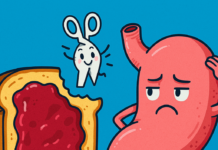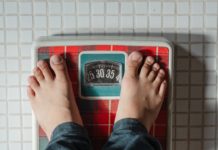As someone who was “diagnosed” with Irritable Bowl Syndrome (IBS) as a youngster, I deeply feel the pain of anyone who has suffered from it. Why did I put the word diagnosis in quotations?
Because a diagnosis of IBS is usually a doctor’s version of saying, “I don’t know wtf you have, but I need to put something on this document.”
If you are here, it means you’re suffering from debilitating gastrointestinal (GI) symptoms, preventing you from living life the way you’d like to. Diarrhea, constipation, bloating, gas, and/or nausea have turned you into a desperate and hopeless person.
Allow me to give you the hugest internet hug ever. I’m hoping this article will give you some hope.
Today I’ll be talking about an extremely healthy, sneaky, frustrating cause of many IBS cases. Read on to find out if it may be the cause for you.
Table of Contents
What is FODMAPs?
When I tell you that there is no one healthy diet for everyone, I mean it. When I say that “good” foods can be “bad” and bad foods can be good, I super duper mean it.
Never is this more true than with FODMAPs.
FODMAPs is an acronym for a bunch of crazy terms:
- Fermentable
- Oligo-saccharides
- Disaccharides
- Mono-saccharides
- And…
- Polyols
No wonder they created an acronym for these dudes, who the heck could remember them?
What are they?
Each term represents various types of short-chain carbohydrates that are present in a TON of foods. Most people can eat these carbohydrates without issue. People who have a digestive issues, such as IBS and/or lack certain types of intestinal bacteria, can suffer horrible GI (gastrointestinal) distress from them.
In order to explain why, I’ll need to explain how your food is processed in your intestines. Yay! I get to talk about poop!
Bacteria and digestion
Microbes everywhere!

Don’t freak out, but inside and all over your body live trillions of microscopic little critters. You’re not as squeaky clean as you thought eh?
Before you run to a shot shower and pour boiling water down your mouth, know the bacteria and fungus residing in and on you are taking care of you. They work hard all day to fight bad evil pathogens and to break down the food you shove into your face.
Microbes and digestion
And boy, do these guys love to be fed! They feed on everything you put in there, but the “good” guy love themselves some fiber. It’s one the reasons why dietitians are always begging you to eat more fiber!
When they’re fed lots of fiber, they ravenously feast and then expel wastes after the meal (just like how we poop and toot after eating). This process is called, “fermentation”. The “wastes” they expel are actually super good for us, such as short-chain fatty acids that support our intestinal health.
But they also “toot” a lot while fermenting. It’s why people who eat high fiber diets toot more than those who don’t.
When things go wrong
Normally, this process works great in a healthy individual. You feeding the good guys and they, in turn, help you to fight against the bad guys. In this scenario, your digestion is fine, your immune health is supported, and you don’t feel like you need to give birth to a godzilla fart after a meal.
However, if you’re someone with a compromised immune system, suffering from some sort of digestive disorder, and/or have starved your good bacteria all your life through a poor, low-fiber diet, multiple rounds of antibiotics, and/or being too clean (yes that can be a problem), then this system breaks.
The types of good bacteria that would normally break down these carbohydrates ain’t there. So the certain carbohydrates sit in your intestines, drawing water into your colon resulting in the much-feared diarrhea.
How your body reacts to this depends. You may only experience painful bloating or constipation, suffer from diarrhea, or a combo of all those symptoms. Bottom line is this: You may be eating foods you think are healthy that are making you feel like crap.
What types of food are FODMAPs?
Here’s the sad part; so many foods fit into this category it can be overwhelming. Most of these foods are considered extremely healthy and are recommended by most doctors and dietitians to consume on a regular basis.
So while you think you’re doing everything right, you could be making things worse.
Top offenders
- Onions
- Garlic
- Apples
- Cherries
- Mangos
- Pears
- Artichoke
- Asparagus
- Certain types of Wheat
- Milk
- Honey
- Agave
Click here for a more comprehensive, if not scary list.
If you are someone who eats relatively healthy, has cut out wheat and dairy products, and still suffers from IBS-like symptoms, you might want to look into FODMAPs causing your problems. People with a compromised immune system, who have taken many and large doses of antibiotics, and/or have mostly consumed a diet of processed foods might also want to look into this.
If you don’t fit into any of those categories, good for you. You can stop reading and go back to browsing Buzzfeed.
What Should You Do?
Seek professional help
First and foremost. Make an appointment with a dietitian!!!
I say this for two reasons:
- The FODMAP diet is extremely restrictive. People attempting on their own might accidentally deprive themselves of important nutrients.
- Again, it’s restrictive. Disordered eating may be amplified with this diet.
- People become so fearful of eating foods that may cause them symptoms, they can develop a version of orthorexia.
A trained professional will be able to guide you through this process.
Additionally, there’s an entire protocol developed by Monash University, the authority on all things FODMAP. It involves elimination, monitoring, reintroducing, and healing the gut. This process also tends to be abused when people do it on their own.
They begin the elimination phase and stay their forever, becoming worse and getting to the point where they feel like they can’t eat anything. So yeah, seek professional help.
If you can’t get help
If you choose to do this on your own, don’t say I didn’t warn ya!
Eliminate
I’d suggest starting small by cutting out the top offenders such as onions, garlic, and apples. Keep a food journal to record what you ate and how you felt afterwards. You may find out that apples trigger you, but onions don’t! We are all different and have different issues with food, so there’s not a “one-size-fits-all” solution.
Monash University makes an amazing app detailing all the FODMAP foods and safe amounts. It does cost money, but what can you do? It is perfect for testing and tracking foods. Link to the website and app is below.
If you notice improvements after cutting out the top offenders, congratulations! You’ve finally discovered what was causing your GI issues! If you feel better but not completely, begin removing more items on the list.
If you remove certain foods high in specific nutrients, make sure you find a FODMAP-friendly replacement to ensure you don’t become deficient.
Heal
The next step would be to improve gut (mainly intestinal) function and health. The issue you have with FODMAPs may be caused from years of damage you’ve accumulated by treating your body like a second-class citizen.
- Cut out FODMAPs (if you have a FODMAPs issue).
- Cut out or reduce processed foods
- Work homemade broths and stocks into your diet. They require little digestion and are packed with nutrients.
- Introduce probiotics into your diet either through supplements or food.
- Only use antibiotics when absolutely necessary.
- Get dirty once and awhile! Work in the garden and get some dirt under your nails. Take all of your antibacterial soaps and throw them in the trash. Please don’t lick a bench though…sheesh…
- To feed the probiotics you’re adding in, increase your intake of low FODMAP foods high in fiber. If your digestion is extremely compromised, introduce cooked veggies as opposed to raw as they are easier to digest.
Reintroduce
Once your gut is functioning better, you need to retest FODMAP foods to see if your new and improved digestion can handle them. This is when you’ll want to keep a very detailed food journal again!
Keep track of friendly foods and not-so-friendly foods. If you have a bad reaction to a food, take note, and give your body at least a day “a break” by eating only friendly-foods.
The end
So good luck citizens! If you’re looking for more information, including recipes, for eating on a low FODMAPs diet, here’s a book you can check out: The Complete Low-FODMAP Diet: A Revolutionary Plan for Managing IBS and Other Digestive Disorders.
For more detailed information on FODMAPs, please reference the links below!
https://www.monashfodmap.com/ (you can download their app from this site)












